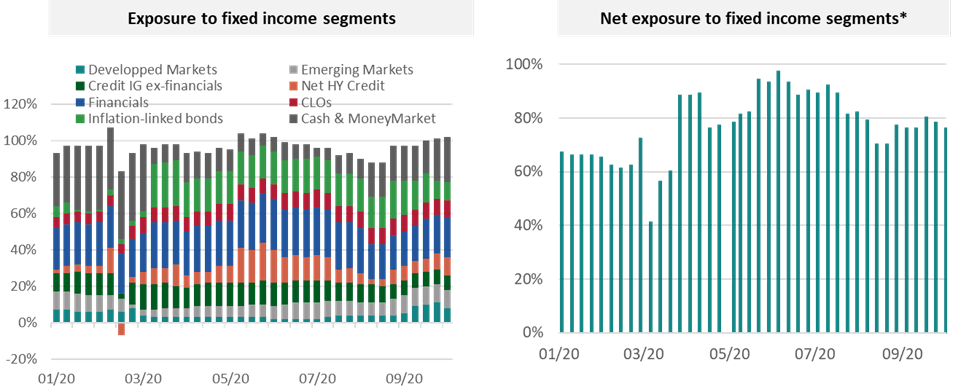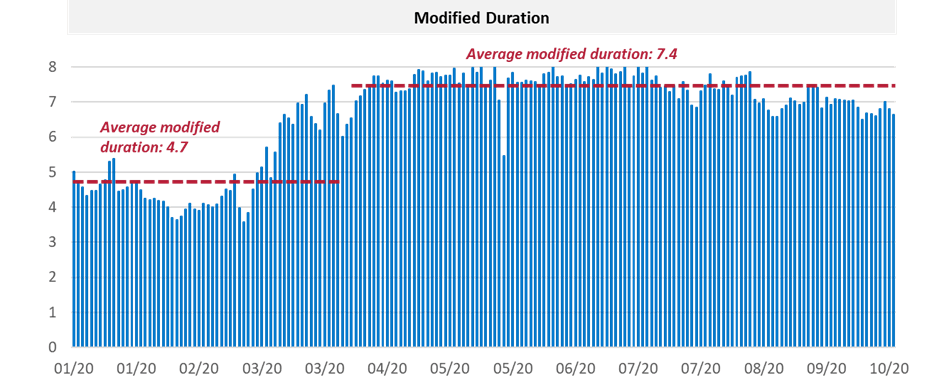Fonds im Fokus

Carmignac P. Unconstrained Euro Fixed Income: the Fund Manager’s thought
Since March 10th, 2021, the new name of Carmignac Portfolio Unconstrained Euro Fixed Income is Carmignac Portfolio Flexible Bond.
The bond market today
After the disruption caused in the first half of the year by the Covid-19 outbreak, the third quarter seemed more placid. Yet it also saw quite a few developments with an impact on bond-market behaviour as almost all market segments booked substantial gains over the period.
-
The Covid-19 pandemic so dramatically affected global economic activity that it drove government and monetary institutions across the board to provide large-scale support.
-
In July, for example, the EU at last agreed on a Recovery Fund that set the stage for ambitious fiscal stimulus programmes. With the number of persons infected by Covid-19 worldwide rising by the end of summer, governments began preparing for a probable second wave, adopting protective policies that would impact the economy, despite the publication of better than expected economic indicators and some progress on vaccines.
US fixed income has in particular felt the impact of the recent policy shift at the Federal Reserve. To help achieve his inflation and job-growth targets, the Fed would now tolerate brief phases of economic overheating and therefore temporary increases in the inflation rate to over 2%. This announcement was enough to steepen the yield curve and strongly support Inflation-linked securities.
Another factor affecting US fixed income has been the country’s feverish political climate with no agreement reached on a new stimulus bill and no clear outlook on the upcoming presidential election. Emerging-world bond markets showed dispersion, but overall credit risk is on the mend being buoyed by US dollar depreciation and by the rebound in commodities.
Portfolio allocation
The effects of the economic downturn have been offset by stimulus policies introduced around the world, leading us to invest heavily during the second quarter in various parts of the credit space. By early July, corporate credit accounted for 64% of our fixed-income allocation. With central banks engaged in an increasingly pronounced economic support drive, we took inflation-linked bonds to 19% of our portfolio at the start of July to benefit from rising inflation expectations and falling real interest rates. We thus entered the third quarter with 91% exposure to the fixed-income market and negligible cash holdings – a sign of the many opportunities the market had to offer at that point.

*Investments – hedging via derivatives – cash & cash equivalents
Source: Carmignac, 09/10/2020
Buoyed by support from governments and central banks, high-risk credit spreads tightened fast, especially in high-yield (+3%) and subordinated financial debt (around +4%) markets. This convinced us to take profits and scale back our exposure to high-yield credit to an exposure at around 9% now.
We have nonetheless left corporate bonds at nearly 50% of our portfolio with two main convictions:
- Some issuers whose businesses took a direct battering from the Covid-19 outbreak (e.g., certain carmakers, aircraft manufacturers, etc.) with significant performance potential.
- Financial bonds, particularly the more junior issues, as they are receiving extremely generous support from central banks and are still benefiting from their efforts over the past several years to clean up their balance sheets.
This ongoing monetary policy easing should sustain low volatility in markets – a plus point for carry strategies. With that in mind, we have made a large investment in Italian government paper (9%), given that political risk is now off the country’s medium-term agenda.
During the quarter, we raised our exposure to emerging-market bonds focusing now on what are the team’s major convictions: the Mexican oil company Pemex, Romania and the Russian fuel and energy consortium. We have been especially active in the market for inflation-linked bonds and have now a substantial 10% exposure to European and US inflation-linked bonds.
Portfolio duration
During the quarter, we maintained our very high duration between 6.5 and 8. In September, we began mildly reducing our overall modified duration, keeping it below 7 years.

Source: Carmignac, 30/09/2020
Past performance is not a reliable indicator of future performance. Performances are net of fees (excluding applicable entrance fee due to the distributor). The return may increase or decrease as a result of currency fluctuations).
We maintain a high duration via hold large positions on the US and eurozone yield curves, and to a lesser extent and for diversification purposes on Australian and UK gilt yield curves, to take advantage of extremely dovish monetary policies.
The second case for maintaining high duration is that it allows us to protect a portfolio heavily invested in corporate bonds in case the economic landscape deteriorates. However, there are also yield curves on which we have opted for negative duration, for example in Hungary and the Czech Republic.
Fund performance
In the quarter, Carmignac Portfolio Unconstrained Euro Fixed Income returned +2.86% (A share class EUR Acc) versus +1.53% for its reference indicator (ICE BofA Euro Broad Index). Practically all the strategies we pursued made a positive contribution to the Fund’s performance. Corporate credit – with differentiated positioning in high-yield, investment-grade and financial bonds – lifted our return by 187 basis points.
We also booked positive results in government bonds from both the developed world (Italy) and the emerging world (mainly Romania). We also gained performance from our exposure to US and European real rates. Regarding duration management, we have mainly benefitted from our Australian bonds.
Carmignac Portfolio Flexible Bond A EUR Acc
| 2014 | 2015 | 2016 | 2017 | 2018 | 2019 | 2020 | 2021 | 2022 | 2023 |
2024 (YTD) ? Year to date |
|
|---|---|---|---|---|---|---|---|---|---|---|---|
| Carmignac Portfolio Flexible Bond A EUR Acc | +1.98 % | -0.71 % | +0.07 % | +1.65 % | -3.40 % | +4.99 % | +9.24 % | +0.01 % | -8.02 % | +4.67 % | +3.04 % |
| Referenzindikator | +0.10 % | -0.11 % | -0.32 % | -0.36 % | -0.37 % | -2.45 % | +3.99 % | -2.80 % | -16.93 % | +6.82 % | -1.17 % |
Srollen Sie nach rechts, um die ganze Tabelle zu sehen
| 3 Jahre | 5 Jahre | 10 Jahre | |
|---|---|---|---|
| Carmignac Portfolio Flexible Bond A EUR Acc | -0.43 % | +1.78 % | +1.09 % |
| Referenzindikator | -4.46 % | -2.83 % | -1.56 % |
Srollen Sie nach rechts, um die ganze Tabelle zu sehen
Quelle: Carmignac am 28/06/2024
| Einstiegskosten : | 1,00% des Betrags, den Sie beim Einstieg in diese Anlage zahlen. Dies ist der Höchstbetrag, der Ihnen berechnet wird. Carmignac Gestion erhebt keine Eintrittsgebühr. Die Person, die Ihnen das Produkt verkauft, teilt Ihnen die tatsächliche Gebühr mit. |
| Ausstiegskosten : | Wir berechnen keine Ausstiegsgebühr für dieses Produkt. |
| Verwaltungsgebühren und sonstige Verwaltungs- oder Betriebskosten : | 1,20% des Werts Ihrer Anlage pro Jahr. Hierbei handelt es sich um eine Schätzung auf der Grundlage der tatsächlichen Kosten des letzten Jahres. |
| Erfolgsgebühren : | 20,00% wenn die Anteilsklasse während des Performancezeitraums den Referenzindikator übertrifft. Sie ist auch dann zahlbar, wenn die Anteilsklasse den Referenzindikator übertroffen, aber eine negative Performance verzeichnet hat. Minderleistung wird für 5 Jahre zurückgefordert. Der tatsächliche Betrag hängt davon ab, wie gut sich Ihre Investition entwickelt. Die obige aggregierte Kostenschätzung enthält den Durchschnitt der letzten 5 Jahre oder seit der Produkterstellung, wenn es weniger als 5 Jahre sind. |
| Transaktionskosten : | 0,38% des Werts Ihrer Anlage pro Jahr. Hierbei handelt es sich um eine Schätzung der Kosten, die anfallen, wenn wir die Basiswerte für das Produkt kaufen oder verkaufen. Der tatsächliche Betrag hängt davon ab, wie viel wir kaufen und verkaufen. |
Carmignac Portfolio Flexible Bond
ZINSRISIKO: Das Zinsrisiko führt bei einer Veränderung der Zinssätze zu einem Rückgang des Nettoinventarwerts.
KREDITRISIKO: Das Kreditrisiko besteht in der Gefahr, dass der Emittent seinen Verpflichtungen nicht nachkommt.
WÄHRUNGSRISIKO: Das Währungsrisiko ist mit dem Engagement in einer Währung verbunden, die nicht die Bewertungswährung des Fonds ist.
AKTIENRISIKO: Änderungen des Preises von Aktien können sich auf die Performance des Fonds auswirken, deren Umfang von externen Faktoren, Handelsvolumen sowie der Marktkapitalisierung abhängt.
Der Fonds ist mit einem Kapitalverlustrisiko verbunden.